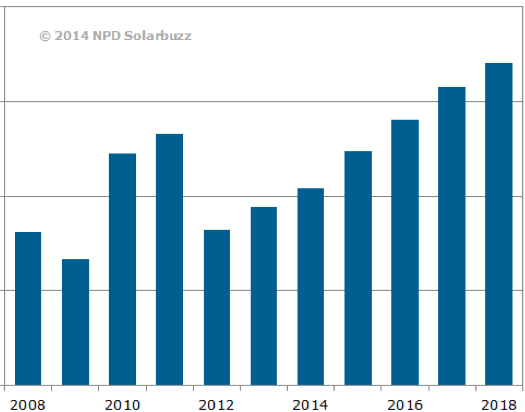The global solar PV industry is headed into a five-year growth spurt that will put it on track for cumulative installed capacity of 500 gigawatts (GW) by 2018, according to the latest NPD Solarbuzz Marketbuzz report.
The report, released on Thursday, predicts a huge 100GW of solar PV deployment will be targeted in 2018 – a boom in end-market growth that is projected to increase annual PV module revenues to $50 billion in that same year.
In January, leading investment house Deutsche Bank also dramatically lifted its near-term demand forecasts for the global solar industry, predicting that 46GW of PV would be installed across the world in 2014, and 56GW in 2015.
Last year, PV developers installed 37.5GW of panels worldwide – a 22 per cent increase on 2012, despite the lingering hangover of global overcapacity and declining operating margins. According to data compiled by Bloomberg, that figure may increase as much as 39 per cent this year, as surging demand in China helps to soak up the glut.
China, which surpassed Germany to become the world’s biggest solar market in 2013, has been forecast to install more than 14GW in 2014, after adding a record 12GW of solar power in 2013, compared with 3.6GW a year ago, according to Bloomberg New Energy Finance.
NPD SolarBuzz says it also expects this strong demand to further stimulate revenues for the industry’s manufacturers, with PV module revenues of more than $200 billion available over the five year period from 2014 to 2018.
“Solar PV module prices declined faster than the end-market grew in 2012, leading to a dramatic decline in revenues,” said Michael Barker, senior analyst at NPD Solarbuzz. “This imbalance was corrected during 2013. Over the next five years, end-market growth will exceed forecasted price declines, resulting in a strong rebound in module revenues.”
The average price of PV modules is also expected to decline moderately, according to NPD SolarBuzz, falling to $0.51 per watt (W) in 2018. System prices, too, will decline each year, driven by cost reductions in balance-of-systems components and economy-of-scale improvements enabled by project developers and installers, says the report.
“Solar PV suppliers are benefiting from a less volatile pricing environment, compared to previous years,” said Finlay Colville, vice-president of NPD Solarbuzz. “The industry will soon transition to a phase of profitable growth, with solar PV competing directly with traditional forms of energy.”











